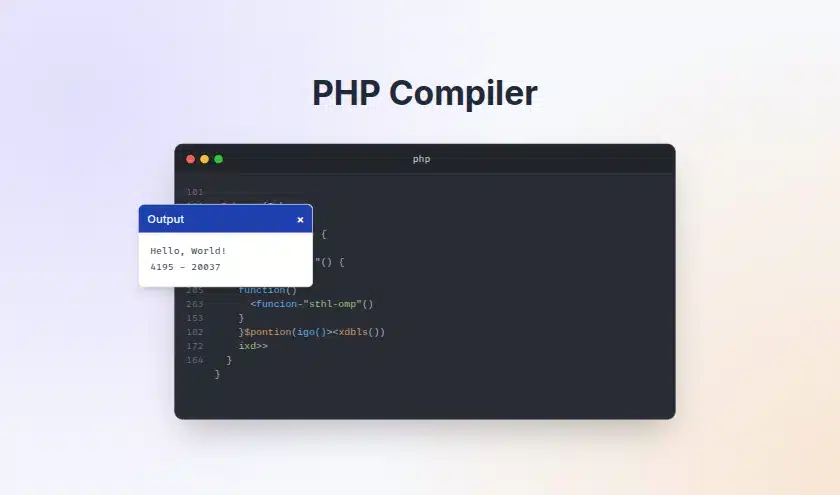When you go for a PHP interview, they test your entire skill set: everything from basic syntax and data types to security and database management.
To make preparation easier, this guide contains 32 important PHP questions, divided into different levels: Basic, Intermediate, and Advanced.
This guide will help you cover all the important topics, whether you’re preparing for a junior-level job or want to showcase your expertise at a senior level.
Beginner PHP Interview Questions
1. What is PHP?
PHP (Hypertext Preprocessor) is a popular and free scripting language used to build websites. It is a server-side language. This means its code runs on the server and then sends the final HTML to the user’s browser. With PHP, you can easily create dynamic pages, interact with databases, and manage user sessions (such as logins and logouts).
Enroll in our free PHP course to learn how to code with this popular server-side scripting language. Learn PHP basics like variables, data types, control statements, loops, and functions through hands-on implementations.
2. What is the difference between echo and print?
Both have the same function of displaying output on the screen, but there are some differences:
- echo can print multiple strings (separated by commas) at once and has no return value.
- print can print only a single string and always returns 1.
Therefore, echo is slightly faster and is used more frequently these days.
Example:
// echo can take more than one argument
echo "Hello", " ", "World"; // Output: Hello World
// print takes only one argument
print "Hello World"; // It returns 1
3. What are the main data types in PHP?
PHP supports eight primitive data types, which are the building blocks for storing information.
- Scalar Types:
- string: A sequence of characters.
- integer: A non-decimal number.
- float (or double): A floating-point number.
- boolean: Represents true or false.
- Compound Types:
- array: An ordered map that can hold multiple values.
- object: An instance of a class.
- Special Types:
- resource: A special variable holding a reference to an external resource (like a database connection).
- NULL: Represents a variable with no value.
4. What is the difference between $_GET and $_POST?
$_GET and $_POST are both PHP superglobal arrays that hold data from a form. However, they differ in how they send it.
- $_GET:
- Data is sent by pasting it into the URL.
- All form data it contains is displayed in the browser’s address bar.
- $_GET also has a limit on the data it can send.
- $_POST:
- Data is not displayed in the URL; it is sent within the request body.
- Therefore, it is considered more secure, especially when sending passwords, form details, etc. The PHP server settings determine how much data you can send via $_POST. These settings are named post_max_size and upload_max_filesize, which are set in the php.ini file.
5. What is the difference between == and ===?
== (equal) only checks whether the two values are equal. However, PHP first converts the values to the same type. This is called type juggling. If one is a number and the other is a string, PHP will convert the string to a number and then compare.
=== (identical) is more strict. It checks that the values are the same and the data type is the same. No type conversion happens.
Example — == with:
var_dump(5 == "5");
// bool(true), because PHP converted "5" to an integer.
Example — === with:
var_dump(5 === "5");
// bool(false), because var is an integer and var is a string.
6. What are include() and require()?
In PHP, both include() and require() work to add the contents of one PHP file to another.
The only difference between the two is how errors are handled.
- require()
If the file is not found or something goes wrong, it will return a fatal error and the entire script will stop. - include()
If the file is not found, only a warning will appear. The script will continue running.
7. What is the difference between include_once() and require_once()?
These are versions of include() and require(), except that their function is to ensure that the file you are including is included only once in the script.
If the file has already been included, these two will not include it again.
This eliminates the problem of re-declaring a function or class, which would otherwise result in repeated inclusion errors.
8. What are sessions and cookies in PHP?
Both sessions and cookies serve to temporarily store user information. However, there are differences:
- Cookie: A small file stored on the user’s computer/browser.
- Session: The data stored on the server.
So, it’s safer to store more sensitive or private information in a session, as it’s not stored on the user’s computer.
9. What does the isset() function do?
The isset() function checks whether a variable has been created, and if it has been created, it must not be NULL.
If the variable exists and is not NULL, it returns TRUE. Otherwise, it returns FALSE.
It is used:
- To check whether the form has been submitted
- Or to check whether a key exists in the array before submitting it
Example:
$name = "Alice";
$age = null;
var_dump(isset($name)); // bool(true)
var_dump(isset($age)); // bool(false)
var_dump(isset($city)); // bool(false)
10. How do you declare a constant?
You declare a constant using the define() function or the const keyword. Once you define a constant, its value cannot be changed. By convention, you should write constant names in uppercase.
// Using define()
define("SITE_URL", "https://example.com");
// Using const keyword (must be at the top-level scope or inside a class)
const MAX_USERS = 100;
echo SITE_URL; // Outputs: https://example.com
Intermediate PHP Interview Questions
11. What are Traits in PHP?
Traits are essentially a way to reuse code from another place. PHP has single inheritance. This means a class can only inherit from one parent class.
But sometimes we need the same functions in two or more classes, and their parent is different.
This is the problem that traits solve.
A Trait is a packet of methods that you can stick into multiple classes, whether those classes have any relationship to each other or not.
Example:
trait Sharable {
public function share($item) {
return "Sharing " . $item;
}
}
class Post {
use Sharable;
}
$post = new Post();
echo $post->share("My new blog post");
// Output: Sharing My new blog post
12. What is Composer?
Composer is PHP’s dependency management tool. You tell Composer which libraries you need in your project. Composer then manages everything by downloading, installing, and updating those libraries. It also handles version conflicts automatically, so that no library conflicts with another.
Explore: Best PHP Project Ideas
13. What are PSR standards?
PSR stands for “PHP Standard Recommendation.” These are a set of rules or guidelines created by the PHP-FIG (PHP Framework Interop Group).
They ensure that different PHP frameworks and libraries can work smoothly with each other and follow the same coding style.
Some well-known PSR standards:
- PSR-4: Autoloading rules for automatically loading classes.
- PSR-7: Standard interface for HTTP request/response messages.
- PSR-12: Detailed rules for coding style compliance.
14. What is the difference between mysqli and PDO?
mysqli (MySQL Improved) and PDO (PHP Data Objects) are both ways of connecting to databases in PHP.
The difference is this:
- mysqli is designed only for the MySQL database. If your site uses MySQL, it will work with mysql, but not with any other database.
- PDO is a little more flexible because it provides a common system through which you can connect to different databases, such as MySQL, PostgreSQL, SQLite, etc. You just need to change the connection string; the rest of the code runs mostly the same.
15. What are namespaces and why are they useful?
Namespaces provide a way to encapsulate items and avoid name collisions. They allow you to use the same class or function name in different parts of your application without causing conflicts. This feature is especially useful in large projects or when you integrate third-party libraries.
// File: App/Models/User.php
namespace App\Models;
class User {}
// File: App/Controllers/UserController.php
namespace App\Controllers;
use App\Models\User; // Import the User class
$user = new User();
16. What are Anonymous Functions (Closures)?
An anonymous function, or closure, is a function that doesn’t have a name. It’s used when you need a one-time function or to pass a function to another function as a callback.
One important thing:
These functions can also use variables from their parent scope, using the use keyword.
Example:
$message = "Hello";
$sayHello = function($name) use ($message) {
echo "$message, $name!";
};
$sayHello("Bob"); // Output: Hello, Bob!
There is no name of the function here, but still it is picking up the message from outside and using it.
17. What is the difference between the final and static keywords?
- final keyword:
- If you make a method or constant final, no child class can override it.
- And if you make the entire class final, no one will be able to extend that class.
- static keyword:
- Using static allows you to access a property or method without creating an object.
- Meaning there’s no need to create an object of the class; simply write the name of the class and you’re done.
- Static methods cannot access
$thisbecause they are called on the class itself, not on an instance of the class.
18. What is type hinting (type declarations)?
Type hinting, now officially called type declarations, means that you specify the data type of a function’s arguments, return value, or class properties in advance.
If someone later provides a value of the wrong type, PHP will throw an error directly.
This makes the code more robust and predictable.
For example:
function calculateSum(int $a, int $b): int {
return $a + $b;
}
// This will run
echo calculateSum(5, 10); // Output: 15
// This will throw a TypeError
// echo calculateSum("5", "10");
19. How does password hashing work in PHP?
Passwords should never be stored in plain text. PHP provides two very useful functions for this:
- password_hash(): To create a secure hash of the password
- password_verify(): To match the user-supplied password with the stored hash
password_hash() uses a strong, one-way hashing algorithm. This means the original password cannot be retrieved from the hash. This function also automatically adds a secure salt, which protects against rainbow table attacks.
Example:
$password = "mySecretPassword123";
$hash = password_hash($password, PASSWORD_DEFAULT);
//Verify
if (password_verify($password, $hash)) {
echo "Password is valid!";
}
20. What is a Ternary Operator?
The ternary operator is a shortcut for if/else. It contains three things:
- Condition (what to check)
- What value to return if the condition is true
- What value to return if the condition is false
This allows you to get the job done in one line instead of writing a large if/else statement.
// Normal if/else
if ($isLoggedIn) {
$status = "Logged In";
} else {
$status = "Logged Out";
}
// Same thing as the ternary operator
$status = $isLoggedIn ? "Logged In" : "Logged Out";
Advanced PHP Interview Questions
21. What are Generators in PHP?
Generators provide an easy way to create iterators without having to write an entire class that implements the Iterator interface.
A generator function looks like a normal function, except that it doesn’t stop at returning a single value. It can yield as many values as needed, one at a time.
This has the advantage of eliminating the need to load the entire list into memory. Data is obtained item by item, so even large data can be handled without consuming memory.
Example:
function getNumbers(int $max) {
for ($i = 1; $i <= $max; $i++) {
yield $i;
}
}
foreach (getNumbers(1000000) as $number) {
// Here the loop will handle only one number at a time.
// All 1 million numbers will not be stored in memory at once.
}
22. What is Late Static Binding?
Late static binding is a feature used with the static keyword. It’s useful when you’re using static inheritance.
- self:: always refers to the class in which the method is written.
- static:: refers to the class that is calling the method.
(This is the magic of “late static binding.”)
See the example below:
class ParentClass {
public static function who() {
echo __CLASS__;
}
public static function test() {
static::who(); // Late static binding is being used here
}
}
class ChildClass extends ParentClass {
public static function who() {
echo __CLASS__;
}
}
ChildClass::test(); // Output: ChildClass
In this example, ChildClass::test() is executed → test() is written in the ParentClass →
But because it has static::who() written in it, it will execute the who() of ChildClass.
So the output is: ChildClass
23. How does PHP handle garbage collection?
PHP uses a reference counting system to manage memory. Every variable has a reference counter.
- When you use a variable, the counter is incremented,
- and when you delete it, the counter is decremented.
When the counter reaches zero, PHP recognizes that the variable is no longer useful and removes it from memory.
But there’s a problem: circular references, where two variables point to each other.
In such cases, if the counter isn’t zero, a memory leak can occur.
To avoid this, PHP has a special garbage collector which detects and cleans the memory containing such circular references.
24. What is SPL (Standard PHP Library)?
SPL is a collection of ready-made tools for solving common problems in PHP. It contains numerous interfaces and classes.
It includes some standard data structures, such as SplQueue, SplStack, SplHeap, and SplDoublyLinkedList. It also contains iterators and other tools that help developers build things in an object-oriented style.
25. What is reflection in PHP?
The Reflection API allows you to reverse-engineer classes, interfaces, functions, methods, and extensions. It enables you to inspect the structure of other code at runtime. For example, you can get information about a class’s properties and methods without needing to instantiate it first.
26. How is SQL injection prevented in PHP?
SQL injection is an attack in which someone inserts malicious SQL code into a query to steal or corrupt database data.
The surest way to prevent this is to use prepared statements, which use bound parameters.
This means that you keep SQL commands separate from user input. Database input is always treated as data, never as code.
Both PDO and MySQLi support prepared statements.
//Example with PDO
$stmt = $pdo->prepare("SELECT * FROM users WHERE email = :email");
$stmt->execute(['email' => $userEmail]);
$user = $stmt->fetch();
27. What is Cross-Site Scripting (XSS) and how to prevent it?
XSS is a security vulnerability where an attacker injects malicious JavaScript-like code into a website, which then runs in other users’ browsers. This means that people viewing your site’s pages are running the attacker’s code without realizing it.
The simplest way to prevent this is to sanitize and escape user data before it appears on the page.
Like using htmlspecialchars() in PHP – it converts special characters like < and > into HTML entities, so that they appear as normal text and do no harm.
28. What is Cross-Site Request Forgery (CSRF), and how is it prevented in PHP?
CSRF is an attack in which an attacker tricks a user into sending a false request. This means the user is unaware of the attack, and some action is performed in their name (such as making account changes, submitting a form, etc.).
The surest way to prevent this is to use an anti-CSRF token.
- The server generates a unique, secret, and unguessable token for each user’s session.
- You then send this token to a hidden field in the form.
- When the form is submitted, the server first checks whether the token is correct or not. If the token does not match, the server refuses to perform any important work.
29. What’s new in PHP 8?
PHP 8 added significant features that make the language faster, more flexible, and cleaner. Important things:
- JIT (Just-In-Time) Compiler:
This makes PHP significantly faster for some heavy, long-running tasks. - Named Arguments:
Now you can pass arguments to functions by name, not by position. Code becomes easier to read. - Attributes (Annotations):
You can add structured metadata directly to code. This makes it machine-readable and useful for tools. - Constructor Property Promotion:
Reduces the hassle of repeatedly declaring properties when creating a class. You can declare and set directly in the constructor. - Union Types:
A single variable can have multiple possible types, such as int|string. Allow a single variable or parameter to accept multiple possible data types, such asint|string. This makes the code more flexible and ensures type safety. - Match Expression:
This is a smarter version of switch. It’s safe, clean, and runs more predictably.
Note: You can use this online PHP compiler to quickly test a PHP script.
30. What are magic methods in PHP?
Magic methods are special methods built into a class, which PHP automatically calls when you perform a specific action on an object.
Their names always start with two underscores (__).
Some common examples:
- __construct() – This method is run immediately when you create a new object.
- __destruct() – PHP calls this before the object is destroyed.
- __get($property) – This method is triggered when you want to read the value of an inaccessible property.
- __set($property, $value) – This method will be run when you try to set a value to an inaccessible property.
- __call($method, $args) – PHP will run this method when you call a method that does not exist or is not accessible.






